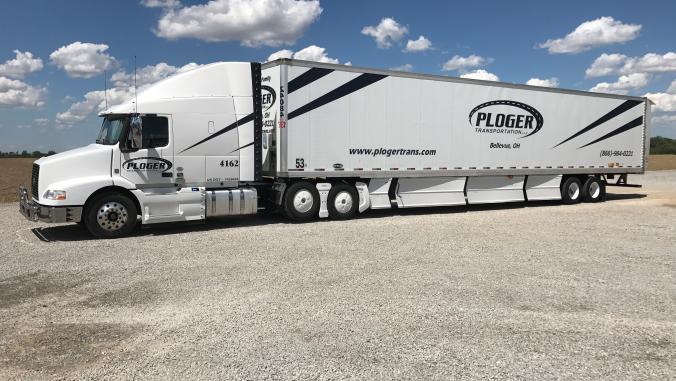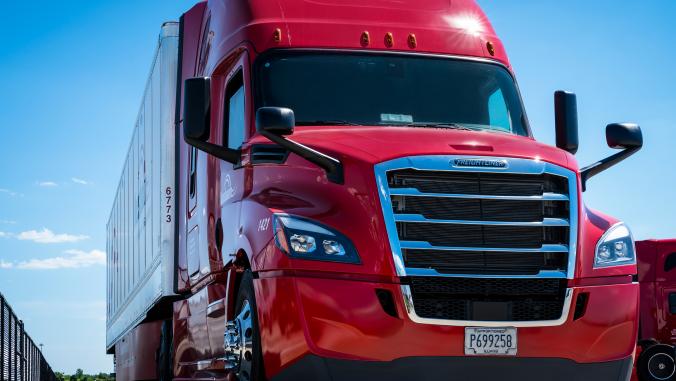Here's concrete evidence that 10 MPG is possible for North American fleets
With technology retrofits, it's possible to squeeze even more fuel efficiency out of trucks already on the road.

Editor’s Note: Run on Less is a first-of-its-kind cross-country roadshow to showcase advancements in fuel efficiency, organized by the North American Council for Freight Efficiency and Carbon War Room. Read part 1 here and part 2 here.
Over halfway through a first-of-its-kind road test of fuel efficiency, the seven participating fleets in Run on Less already have demonstrated that achieving 10 miles per gallon is possible in the real world.
In fact, the cumulative average MPG recorded by the seven trucks representing Albert Transportation, Frito-Lay, Hirschbach, Messila Valley Transportation, Nussbaum, Ploger and USXPress is 10.1. That’s 12 percent higher than what was anticipated going into the run, a cross-country "race" to showcase advancements in fuel efficiency.
The results confirm our suppositions, even calculations, that trucks can use much less fuel than the national average consumption, and that drivers are not exaggerating when they say they can achieve up to 10 MPG consistently or even up to 13 MPG on certain days. Run on Less is enabling these truckers to demonstrate their contribution to our economy, to their fleets and to the wider public.
The trucks drove a combined total of 31,000 miles and saved 1,800 gallons of fuel in the first 10 days. If the 1.7 million trucks on the nation’s highways today achieved the same level of efficiency as the trucks participating in Run on Less, the sector could realize cumulative savings of 9.7 billion gallons of diesel fuel, $24 billion and 98 million tons of carbon dioxide.
The results confirm our suppositions, even calculations, that trucks can use much less fuel than the national average consumption.
The fleets agreed to participate in Run on Less to demonstrate how their investments in technology have paid off in freight efficiency improvements, even with fuel prices at relatively low levels.
These early results should encourage other fleets to consider technologies such as side skirts, trailer tails, powertrain improvements, low-rolling resistance tires, tire pressure systems, solar panels or any of the 85 technologies that the North American Council for Freight Efficiency (NACFE) has identified for fuel-saving opportunities.
While no fleet can use all 85 technologies, the fleets participating in Run on Less are already demonstrating how a variety of combinations of technologies can work together for significant fuel savings on a day-to-day basis.
And while some fleets have made the needed investments, many fleets still have not done so. Barriers to technology adoption still exist. One reason cited by the council in its report, "Barriers to the Increased Adoption of Fuel Efficiency Technologies in the North American On-Road Freight Sector (PDF)," is a lack of credible information about these options.
Run on Less, an initiative driven by NACFE and the Carbon War Room initiative, is hoping to break down some of those barriers. While the results of the run could be seminal for North American trucking, the industry has been making great strides with respect to fuel economy. For example, with its comprehensive, standardized system for tracking, documenting and sharing information about fuel use and freight emissions, the U.S. Environmental Protection Agency SmartWay program has been helping fleets make decisions, and manufacturers develop, produce and scale products to dramatically improve efficiency. The program provides a comprehensive, standardized and well-recognized system for tracking, documenting and sharing information about fuel use and freight emissions across supply chains.
While large fleets may have the ability to test a variety of vehicles and technologies in their operations, mid-sized and small fleets, as well as owner-operators, may not have the resources to test products. We hope that Run on Less will provide data that incents these groups to consider efficiency technologies they otherwise may not have deemed accessible.
Final results for the run are scheduled to be shared next week at a press conference before the start of the North American Commercial Vehicle show in Atlanta.





